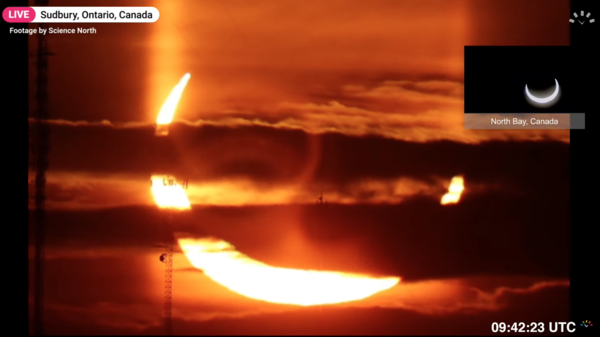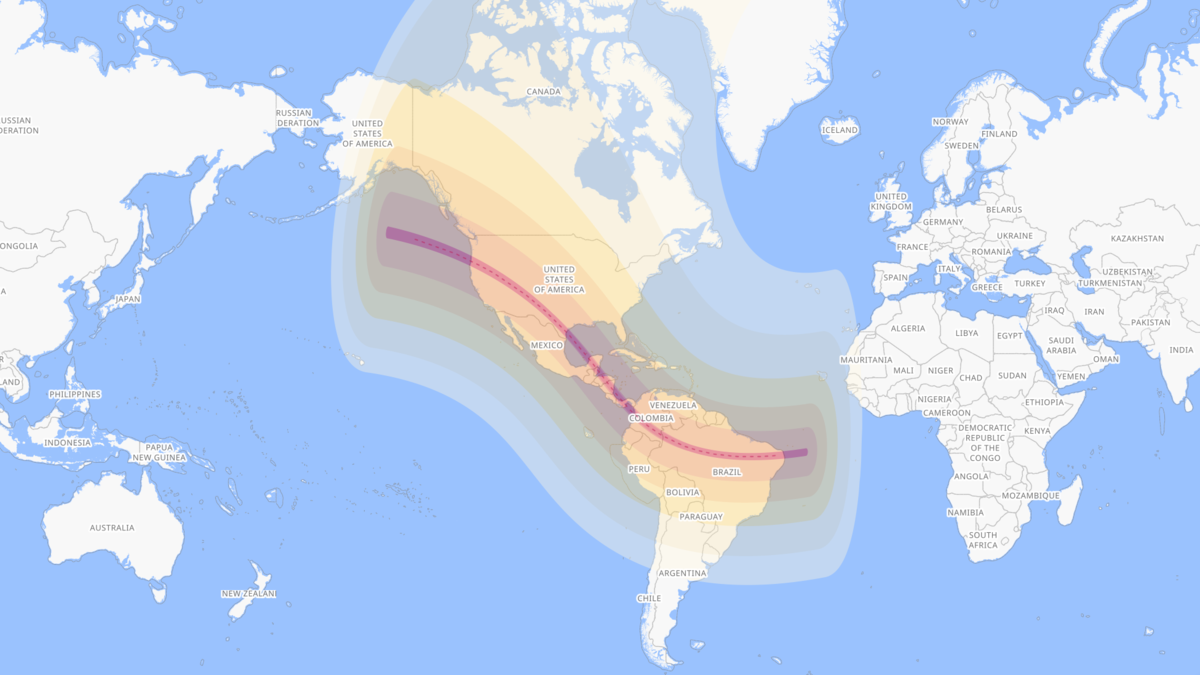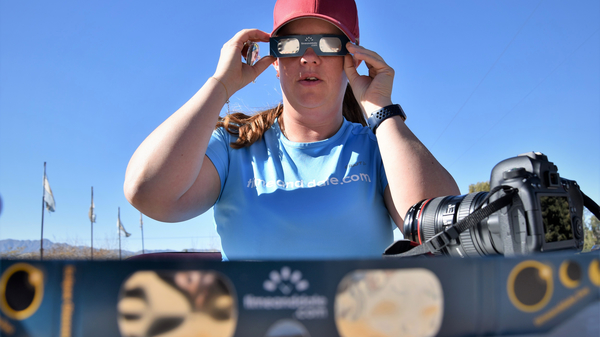Don’t Miss the 2023 Annular Solar Eclipse
On October 14, an annular solar eclipse will sweep across North and South America. The timeanddate team will be on the ground in Roswell, New Mexico, streaming it LIVE to you.


A partially eclipsed sunrise—during our live show of the annular solar eclipse in June 2021—looking like “devil’s horns” rising up from the horizon in Ontario, Canada.
©timeanddate.com
Great American Eclipse 2023
On Saturday, October 14, 2023 the Moon will cross the face of the Sun, and an annular solar eclipse will be visibe in the Americas.
This eclipse is the second of three “Great American Eclipses:” the first was a total eclipse in 2017, and the next will be another total solar eclipse in 2024.
What States Will See the Annular Eclipse?
An annular eclipse happens when the Moon is farther away from Earth and is too small to cover the Sun completely. Instead, the Moon becomes a silhouette, surrounded by a golden ring of fire.
In the United States, annularity is visible along a narrow path that crosses Oregon, California, Nevada, Utah, Arizona, Colorado, New Mexico, and Texas.
Beyond the US, annularity will be visible in the Yucatan peninsula in Mexico, Guatemala, Belize, Honduras, Nicaragua, Costa Rica, Panama, Colombia, and Brazil.


The path of annularity for the October 2023 solar eclipse is the dark red ribbon on this map (the dotted line marks the center line of the eclipse). A partial eclipse will be visible in the shaded areas.
©timeanddate.com
Partial Eclipse in North, Central, and South America
A partial solar eclipse—where the Moon covers some, but not all, of the Sun—will be visible in the rest of the Americas—including all states and provinces in Canada, all 50 states in the US, and the northern parts of Chile and Argentina.
In Los Angeles, the Moon will cover 71% of the Sun. In Dallas, 81% will be covered; Miami gets 58% coverage; Chicago, 43%; and in New York, 23% of the Moon will be in front of the Sun.
What Time Does the Eclipse Start?
Because the Moon’s shadow moves across Earth’s surface, the local time of a solar eclipse depends on your location.
Find local eclipse times in the US
Observers within the path of annularity will first experience a partial eclipse, then annularity, followed by a partial eclipse again.
We’re Streaming It All Live
The timeeanddate team will be on the ground livestreaming from Roswell, New Mexico, weather permitting. We’re showing the entire six-hour eclipse from when it starts in Oregon, US, to when it ends in Brazil.
In Roswell, partial starts at 15:15 UTC, and annularity starts at 16:38 UTC. Annularity—when the Sun forms a ring of fire around the Moon—will last 4 minutes and 41 seconds.
Find your local time for the livestream
Our live broadcast of the 2023 annular solar eclipse. ©timeanddate.com
An eclipse never comes alone—two weeks later, on October 28–29, a partial lunar eclipse can be seen on the night side of Earth. We will also stream the lunar eclipse LIVE from our timeanddate HQ in Stavanger.
We collaborate with astronomers around the world
Eye Safety: Must Use Eclipse Glasses
If you’re on the ground, please remember: at no point during an annular eclipse does the Sun completely disappear. Never look at the Sun without proper eye protection.
“At maximum eclipse, 91% of the Sun will be covered by the Moon. The remaining 9% of the Sun’s disk will form a blazing ring around the dark side of the Moon.”
“This is an important reminder that, during an annular eclipse, eclipse glasses must be used at all times—even during annularity,” timeanddate’s astrophysicist Graham Jones says.

timeanddate’s Anne Buckle (that’s me), demonstrating the correct way put eclipse glasses on during a total solar eclipse in Argentina in 2019.
©Anibal Heredia
Great American Eclipse 2024
About six months from now, on April 8, 2024 a total solar eclipse will grace the North American skies. The path of totality will start in Mexico, with the Moon’s shadow moving across North America and ending in Newfoundland and Labrador in Canada.